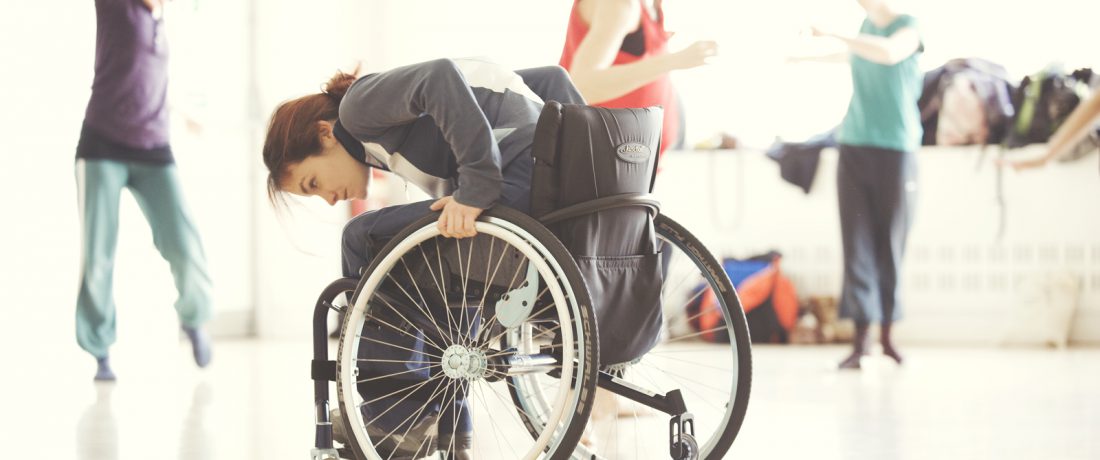
The Meeting Body and Space
an inclusive dance class
TARGET GROUP
mixed level (beginners, intermediate & advanced dancers)PARTICIPANTS
15DURATION
1.5 hoursORGANIZATION
Holland Dance FestivalGoal - Essential question
Getting in contact with our body, our partners and the space around us.
Meeting the group in circle (5 minutes)
Sit on the floor in a circle. Dancers introduce themselves by telling their name and – if they feel the need – share what might be important for the group to know relating to the dance class.
Warming up & meet your colleagues (10 minutes)
Dancers move/improvise through space. Teacher calls the name of one of the dancers. He/she freezes, the rest of the dancers wave to the frozen dancer and repeat his/her name with the voice out loud. Repeat with all dancers.
Music: Music with a swing
Outcome: learn the names of the group members.
Meeting the dancing space & each other with freezes (15 minutes)
Dancers move/improvise through space. Teacher claps her hands, all dancers freeze.
First dancers create their own freeze. Then the teacher decides the kind of freeze: small, big, touching the floor with 1/2/3 body parts. Moving through space, when the music stops, each dancer finds a partner; make a freeze together: close together or touching body parts (making own choice or the teacher decides) or just melt together as one.
Music: spicy music/fast tango.
Outcome: discover the moving space and other dancers in movement.
Meeting 2 by 2 with body contact (15 minutes)
Dancers work 2 by 2. Spread through the space 2 by 2, contact improvisation; reflect with group.
The eyes are closed, backs against each other. (or if not possible, find another body part to touch)
A. Gently they start moving together, staying nearby their own place.
Dancers try to feel:
* each other’s’ warmth
* points of contact
* each other’s’ breathing through the back
B. Enlarging the movement, feeling the change of contact points of the back
C. Play with weight, giving more/less and find out what happens: start moving through space. While moving, make variety in moving on the spot and/or through space in different directions and height levels. Leading/following without talking, just feeling each other’s leadership.
Outcomes: explore your own and partners’ movement/body, feel safe to improvise with physical contact; being able to reflect on physical/movement/motorial elements, space elements and social/emotional elements
Structured exercise: meeting your body into space (20 minutes)
Spread in center, facing front; repeat phrase 4 times 1/4 turn, starting front, side, back, side.
Dancers put hands on their knees and when possible, bend the knees. Brush with right hand from shoulder to wrist over right arm and the same with left hand over right arm. Reach forward with both arms. Open up chest, with arms opening to the side. Move forward. Stand still (stop) and turn upper body, 1/4 to the right (feels like a twist). Make a 1/4 of turn to the left with the whole body, and end up facing the other direction. Repeat the whole phrase end facing the starting position after 4 times.
Teaching method: Teach the separate movements (words: brush, brush, reach, open, move forward, stop, twist, turn) and create a full phrase. Dancers can make their own dance translation. If all dancers know the phrase they can dance it in their own tempo and rhythm. After dancing the phrase several times, try to find a group-tempo/rhythm.
Music: with a strong beat, in a middle tempo
Outcomes: learning and remembering a structured dance-phrase; being able to dance it in different directions; collaborating in finding a group-rhythm.
Variations on exercise 5 (20 minutes)
(Choose 1 or 2 of the variations to work on)
Using the same combination and: Dancers create/compose their own phrase with the separate movements of the combination they learned: vary in order, timing, directions etc. Dancers create/compose their own phrase based on the original phrase, working 2 by 2 starting mirroring each other.
Take time to explore, to settle and practice the new phrase.
(If dancers are confident enough they can even present their duets to the rest of the group.) In the next class, or if there is enough time, you can change partners.
* Try different kinds of music, and find out how music can influence the color, dynamics, tempo and rythm of the movements.
* Work in couples, try to add physical contact in the duets.
Music: tango music, music without a strong beat, slow and lyrical.
Outcomes: dancers work on composition or collaboration with a dance partner or working on musicality; working on collaboration with partnering/physical contact depending on the chosen variation.
Cooling down (5 minutes)
Dancers are in a big circle, eyes are closed.
They slowly and easily move body parts (isolations) called by the teacher. Feel and concentrate on the body after this dancing class. Moving in different directions and levels of height.
Music: watery music
Outcome: reflecting the body after class while moving.
